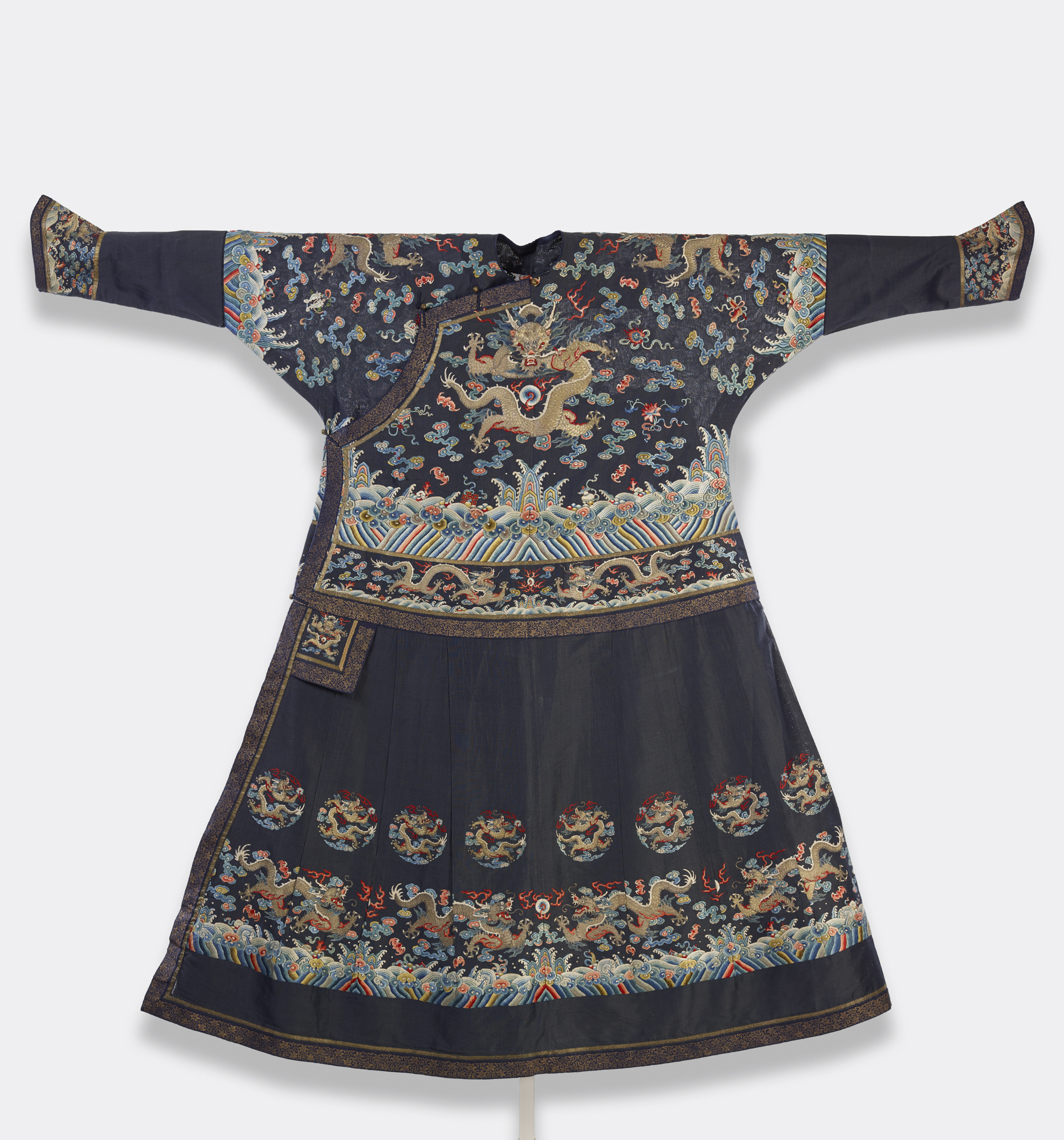This robe for a man is called a chaofu(chow-foo) literally, “audience robe”; a dress that the emperor, nobility, and court officials wore for formal occasions. Design and decoration of chaofu depended on the rank of the person who wore it.. It has long sleeves, a hip-length bodice attached to a pleated skirt, and fastens at the side. The silk cloth is dark blue gauze, an airy material that indicates it was for the summer (winter chaofu were of heavier silk with fur lining or trim). The garment is brilliantly embroidered and glitters in the light. Large gold dragons with silver highlights appear prominently positioned in a symmetricala mirror image in which objects on one side of an imaginary line are exactly like objects on the other side. arrangement on the front and back, as well as on each shoulder. Eighteen small dragons in roundels appear on the skirt. Dragons are auspicioussuccessful or prosperous; a sign of future success animals that embody masculine power and symbolize imperialrelating to an empire, an emperor, or the home of royals. majesty. The number of claws the dragons have (five-clawed) indicates this chaofu was worn by a high-level member of the imperial family. The dragons are surrounded by symbolsshapes or designs that are recognizable and have a meaning associated with them of good fortune such as five-colored clouds and bats, as well as by eight Buddhist treasures of which the lotus flower is one. Underneath the dragons on the front and back of the chest, deep water portrayed by colorful diagonal bands is pierced by a mountain at the center. Clouds float above. The design elements together reflect the Chinese conception of the cosmos.
China has captivated the world for thousands of years with its skill and creativity in working with silk. The Qing dynastythe last imperial dynasty of China, 1644–1911., which lasted from 1644 to 1911, is especially known for its luxurious silk textiles. This robe, a chaofu(chow-foo) literally, “audience robe”; a dress that the emperor, nobility, and court officials wore for formal occasions. Design and decoration of chaofu depended on the rank of the person who wore it., exemplifies the grandeur of Qing(ching) court costumes and is in pristine condition despite its age. It was intended to be worn on important occasions, such as court assemblies or state sacrifices. It is a rare surviving example of dress for a high-rank prince; because only a few individuals were of the rank that allowed them to wear this type of dress, not many were made. Moreover, owners often chose to be buried in them, as they were their most precious garments. There were detailed regulations written by court officials about the appropriate materials, style, and decoration for chaofu to be worn by different ranks of the nobility and court officials. The number and position of the dragons on this chaofu are what tells us that it belonged to a high-rank prince.
The chaofu(chow-foo) literally, “audience robe”; a dress that the emperor, nobility, and court officials wore for formal occasions. Design and decoration of chaofu depended on the rank of the person who wore it. was the most important court dress in China’s Qing dynastythe last imperial dynasty of China, 1644–1911. and it incorporates features from different cultures. The rulers of China in the Qing(ching) were ethnically Manchus, and in this garment, both Manchu(man-choo) ethnic group that lived for centuries in the northeast of modern-day China. In the seventeenth century CE, Manchu people conquered China and ruled there for more than 250 years. and imperialrelating to an empire, an emperor, or the home of royals. Chinese dress traditions have been referenced. For example, the cuffs are shaped as horse hooves (broad at the top and narrow at the bottom). They resemble the bottom of the sleeves worn by Manchu hunters and archers. Such sleeves were made to be rolled up in daily life and lowered when hunting to warm the hunter’s hands without affecting shooting. However, for this imperial garment, the shape is symbolic and was not worn on a hunt. The pleated skirt and dragon decoration are traditions incorporated from native Chinese dress. The chaofu thus embodies the Qing court’s mandate to rule over a multiethnic empire.
- Look closely at this robe and zoom in on the details. How many different animals and symbolsshapes or designs that are recognizable and have a meaning associated with them can you find? What do you think these symbols convey about the person who wore this?
- Zoom out and look at the design of the robe overall. What words would you use to describe the style of this robe?
- The elegance and expense of this robe signified the power and status of the owner. How do we identify people of different levels of importance or office through their clothing? Is it important to do so? Why?
- Why is it important for people to have specific clothing for special occasions? What are some pieces of clothing you have that are for a special occasion? What sets them apart from other clothes?







